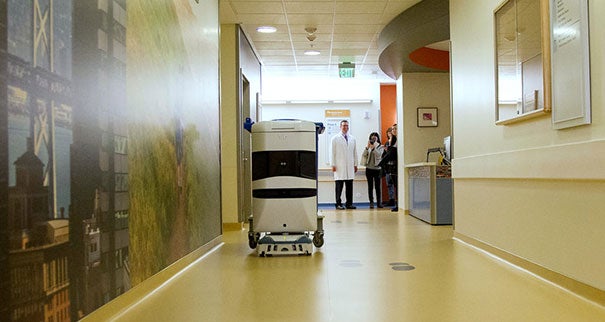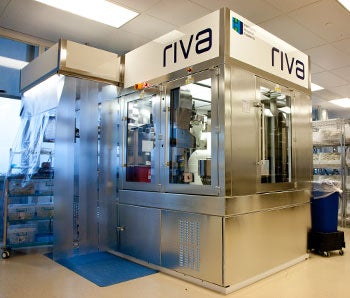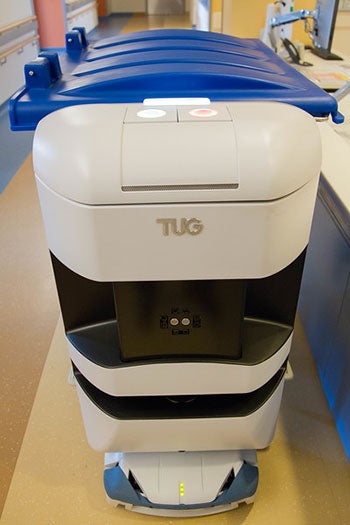Are robots a permanent health care fixture?
When UCSF Medical Center Mission Bay welcomed its first patients in February, they were greeted not only by medical and other staff, but also 25 TUG robots. The new center spans more than 600,000 sq. ft. and the TUGs are expected to average more than 1,300 trips per day.
 |
| Photo by Susan Merrell/UCSF The TUG robots at UCSF Medical Center are anticipated to collectively travel 315 hours per day, totaling 481 miles. |
The idea behind the robots is to free up employees from shuffling to and fro when their time can instead be spent interacting with patients. The robots handle such tasks as transporting food, linens and specimens around the facility.
 |
| Photo by Susan Merrell/UCSF The RIVA machine, which is part of the UCSF Medical Center robotic pharmacy, compounds chemotherapeutic drugs. |
It's not the first time the Bay Area health system has used robots to handle important jobs in the hospital. UCSF Medical Center has been using an integrated medication management system in its pharmacy since 2011. It serves multiple UCSF facilities. Suzanne Leigh, a spokesperson for UCSF, says the health system administers 1.2 to 1.3 million doses per year and the robotic pharmacy has the capacity to serve 1,000 inpatients daily. Since the robotic pharmacy was installed, it has only made one error, and that was the result of human input. A system was put in place to prevent future mistakes.
"The robotic pharmacy reduces the potential for medication errors," Leigh says. "It also frees up the pharmacist to spend more time at the bedside discussing medication regimens with inpatients, such as how they should be administered and potential side effects."
While the hospitals that use them and the manufacturers that create them talk about robotic hospital helpers as time- and cost-saving tools, one Wired reporter has referred to the TUGs used in UCSF Mission Bay as "creepy," even using the word "hate" in the headline of an article. The writer mentions others in the article that shared a similar sentiment.
 |
| Photo by Susan Merrell/UCSF UCSF Medical Center employees have named some of the TUGs after Disney characters, such as Wall-E and Eva. |
So, are robots in the hospital creepy, or is it simply the opinion of one creeped-out writer? In the age of the patient experience, it's an important factor to consider. On one hand, these machines are meant to politely take on some of the manual labor so that staff can focus on patient comfort. It would be a shame if the robot's very presence backfired in trying to fulfill that purpose.
In an article on automation in health care, Debra Ann Maleski discusses the many types of robots on the market today, and factors to consider when integrating them into a hospital's operation. She says that robot demand in hospitals is "projected to grow exponentially because of their many advantages," including replacing humans in potentially unsafe situations. UCSF, for instance, uses its robotic pharmacy to prepare oral and injectable medicines, including toxic chemotherapy drugs.
Creepy or not, enthusiastic robot adopters, such as UCSF Medical Center, suggest that robots are here to stay. In fact, the health system has begun naming its TUG robots, many of them after Disney characters.




